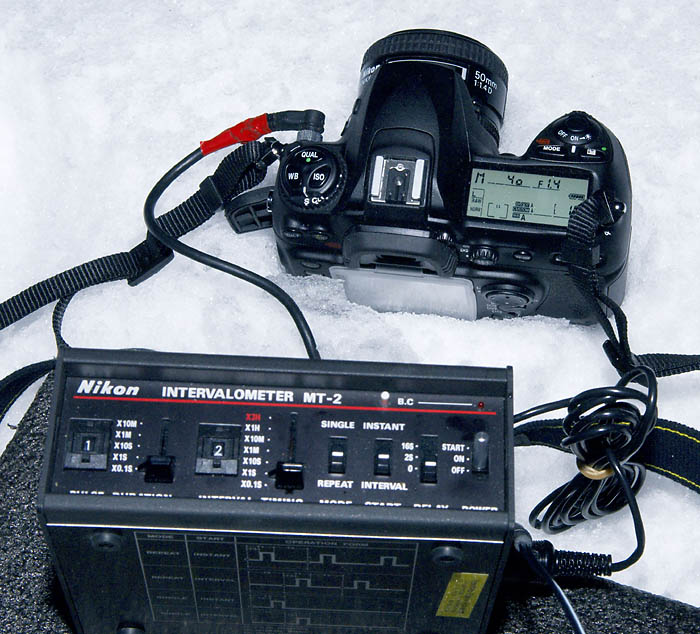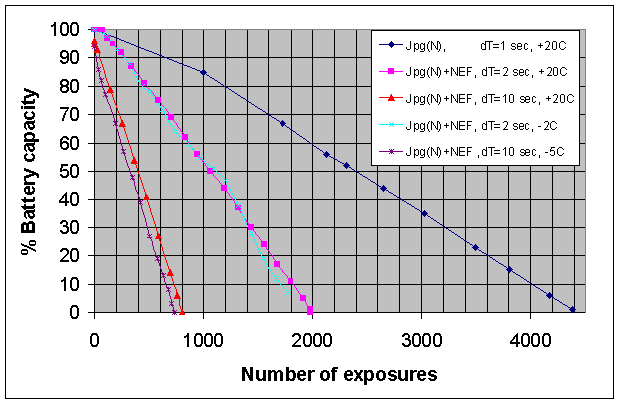 |
|
| Setup for testing battery capacity under realistic field conditions. I'm using an external intervalometer (Nikon MT-2) instead of the D200's built-in timer feature, to eliminate any influence from the internal circuitry of the camera. |
| Nikon D200 Digital Camera Reviewed | |
| by Bjørn Rørslett | |
3.
Battery Performance
Any digital camera without batteries is just a heap of metal and plastics, with no immediate usability. Nikon provides the EN-EL3e battery with the D200. It is a further refinement of Li-Ion technology launched with the EN-EL3 of D100. The EN-EL3e has a built-in microchip and a third contact pin to allow the camera to communicate with the chip. Having access to these read-outs is mandatory for the camera to function. You may easily verify this by putting a piece of tape over the new, centre pin on EN-EL3e and sticking it into the D200; the camera won't come alive unless the tape is removed.
Thanks to the chip, the battery can report its status in great detail, providing data such as the number of shots taken on the current charge, the estimated % capacity left, and the stage of its charging life-cycle on a 5-point scale (0= New to 4=End of Life, replace with another). You cannot use the older types EN-EL3/3a in the D200 due to their lack of the third read-out pin, but the other way around is just fine, so if you combine a D200 with a D70, say, all you need to power both is a pair of EN-EL3e units. Note that your EN-EL3e might need several cycles of being drained in the camera, then recharged, to attain stable performance.
In their D200 brochure, Nikon gives some sweeping statements as to the battery capacity of the EN-El3e. Many people misinterpret this information and complain that they are not getting similar figures themselves. I'm always a little provoked to laughter when I encounter such discussions. For example, one guy complains about "only" getting 100 exposures per charge and another says "hey, I'm getting 1.000 so you must have a defective battery!" The basic, but frequently overlooked, idea here is that you can not compare shooting numbers obtained by different photographers. There is no common base in such numbers, and comparing them really is a futile exercise. Only when everything is similar in the total setting (same pattern of shooting habit, same diversity of lenses, same ambient temperature, same way of accessing and using camera controls and LCD panels, and so on) can you compare numbers (in statistics, this is called longitudinal comparisons). The one and same photographer might compare battery performance of one of his cameras to another he's using, that is a justified comparison. Otherwise, it is not. Sorry to elaborate on such basics but it evidently needs to be hammered upon over and over again.
So, what should interest us is which feature of the camera exerts the biggest drain on the battery. In order to answer questions like this, one needs to set up experiments in a careful fashion, so as to keep the relevant variables under strict control.
 |
|
| Setup for testing battery capacity under realistic field conditions. I'm using an external intervalometer (Nikon MT-2) instead of the D200's built-in timer feature, to eliminate any influence from the internal circuitry of the camera. |
I ran the test in a set of typical conditions, high (+20° C) to low (-2° C to -5° C) temperatures, with image preview switched off or on, with jpg (Normal, Large) only or combined with NEF (uncompressed). The battery unit was cooled down before being recharged and immediately after the charge had completed, put into the camera to start a new experiment. I used an external intervalometer to control the camera. The lens in question was, as seen above, my AF 50 mm set to f/1.4 and camera on "M" and 1/40 sec. For the outdoor runs, I simply placed the camera into the snow pack outside my house. Always more enjoyable to sit indoors and sip warm coffee than to be outdoors during those torture runs.
 |
|
| Figure
1. Plot of battery capacity and number of exposures
obtained under controlled conditions. dT describes the interval between each shutter release as follows, dT= 1 or 2 sec: no Image Preview dT = 10 sec: Image Preview On for 8.5 secs per cycle |
So, how are these results to be interpreted? The first and obvious answer is that the battery can deliver a very wide range of exposures, depending on the actual test conditions. The results bracket the figures given by Nikon, too, so obviously Nikon's official claims are valid.
Let us examine the results in more detail. Firstly, note that moving nearly twenty times more data (NEF plus jpg Normal is approx. 17 MB vs. jpg Normal only at an average around 1 MB) drains the battery twice as fast. Another way of stating this is that shooting only jpgs will double battery performance. Alternatively, the extra cost incurred by shooting NEF + jpg instead of just plain NEF is negligible.
Secondly, if you enable automatic image preview, this will cost you again at least half the battery capacity. Put otherwise, the LCD panel is huge, and it eats battery power. If you browse the menus or use image preview a lot, be prepared to get a much lower number of shots per battery charge. Half the number is a reasonable estimate.
Thirdly, lowering temperature from +20° C to slightly below the freezing point (-2° C to -5° C) reduced the battery performance only by 5-15 %. This is quite surprising, but well corroborated by the results of the test runs. Additional observations indicate that the battery will drop its estimated capacity when used in cold weather, but revitalise when the battery has seen a break in use.
Last point is the EN-EL3e does a lot of internal reassessment of its reported remaining capacity. You can see this from the wiggling of the sub-zero curves. Furthermore, a "dead" cold battery when warmed up to indoor climate will again report a remaining charge. A basic fact of Li-ION technology is that the internal circuits should shut off the battery before its internal voltage drops to dangerously low levels, at which point metal shunts can form inside the battery to damage it permanently. Evidently Nikon has programmed the microchip of the EN-EL3e to shut down way before any critical limits are reached. Thus you have a considerable safety margin at your disposal.
The attentive reader may have noticed that the tests above do not evaluate impacts of AF use on EN-EL3e capacity. This is indeed true, but bear in mind that the setup aimed to duplicate my use of the camera. I'm using manual modes a lot and don't do much AF. So to me, the tests are highly relevant. Besides that, they contribute to a well-founded understanding of the factors responsible for draining the camera's battery. My guess from another, not complete, test series is that AF use drains pretty much as using the LCD panel does, thus again halving the capacity. From this we can estimate that using the Image Preview in a diligent manner, plus doing a lot of AF, will give battery performance around the lower numbers provided by Nikon in their D200 manual. Shot like this, you can expect to get just one-third to one-fourth of the number of exposures attainable were the camera used in manual mode with no AF. The choice is yours, and the sensible solution as always is of course to bring along some spare batteries.
Finally to give my own answer: I got on the average about 170 shots per charge with the D200, compared to 390 with the D2X. This is using each camera for a typical mix of shooting applications in sub-zero weather. As far as I'm concerned, the D200 (with EN-EL3e) has slightly less than half the shooting capacity of the D2X (with EN-EL4). Thus I will have to carry at least one extra spare battery for each D200.